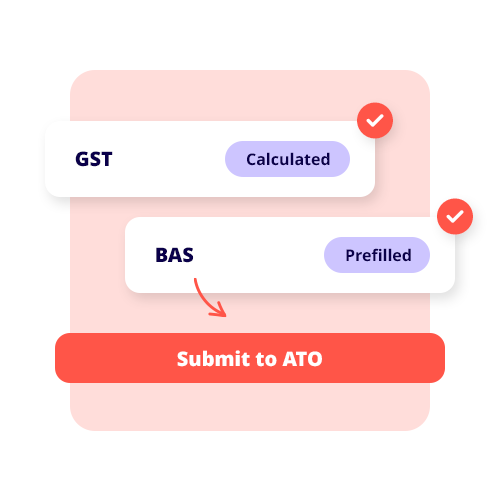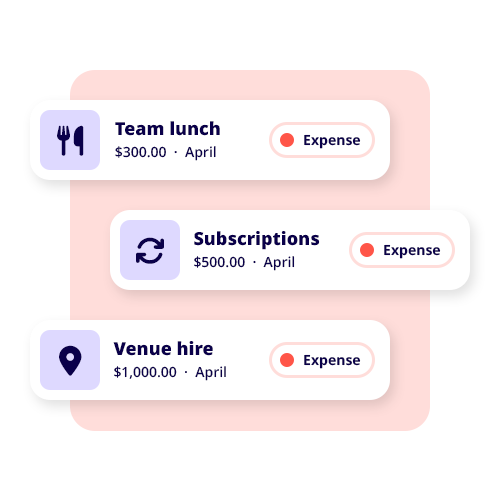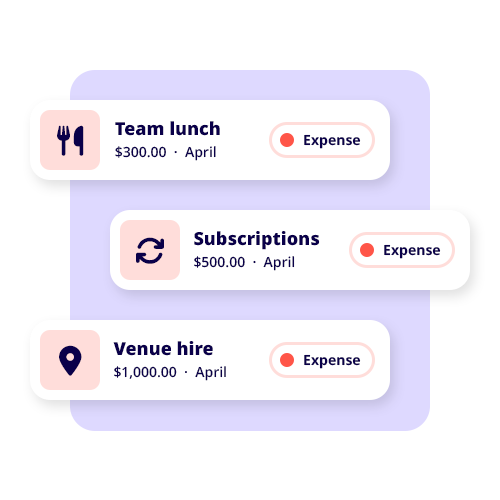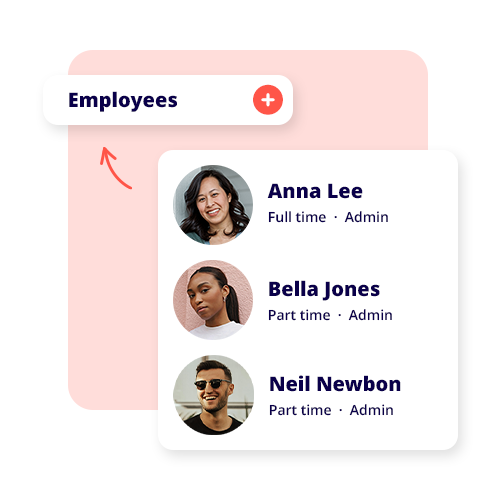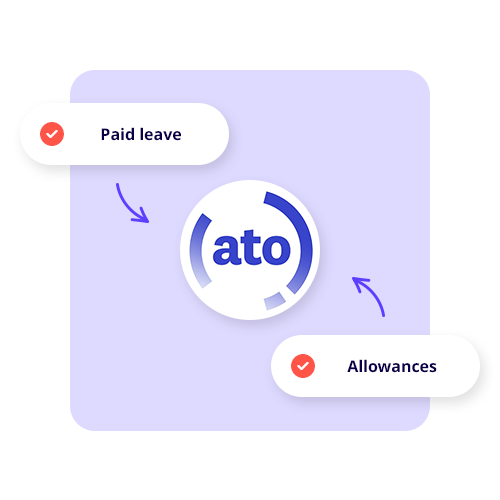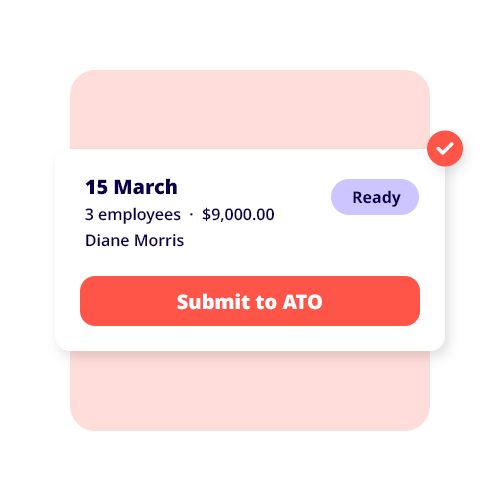Starting or formalising a not-for-profit (NFP) is pretty exciting – and also a little admin-heavy. If you’re just getting started and need to know what ‘not for profit status’ actually means, as well as how Australian charities fit inside the wider not for profit sector, you’ve come to the right place.
NFP vs charity: What’s the difference?
Not-for-profit organisations don’t exist to provide a profit or other benefit to particular people (e.g. members, founders, or relatives). They can, however, earn income and even generate a profit, but that money must be applied solely to the organisation’s charitable or community purpose and not distributed directly or indirectly to individual members.
If the organisation closes down, assets can’t flow on to members. Instead, they have to transfer to an organisation with similar purposes. This principle is usually locked into your governing document via a not-for-profit clause and a dissolution clause (i.e. using language like “Upon such dissolution, assets go to a charity with similar purposes, not to members, except as genuine compensation for services rendered or expenses incurred on behalf of the organisation”).
A charity is a specific kind of NFP with a recognised charitable purpose and a public benefit. Charities must register with the Australian Charities and Not-for-profits Commission (ACNC) to operate as registered charities and enjoy charity tax concessions. Non-charity NFPs still have to interact with the Australian Taxation Office (ATO) for tax matters.
Choose a legal structure (before you apply)
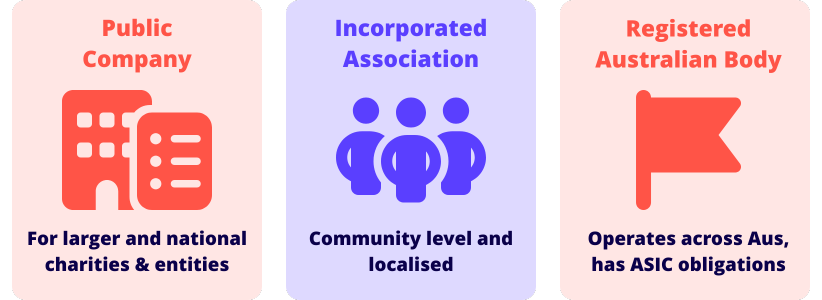
There are different ways to structure your NFP organisation. Your choice will ultimately impact how you register, which regulator you file with, how you handle ongoing reporting, and where you can operate. The most common types of legal structures are:
- Public company limited by guarantee (under the Corporations Act): Usually for bigger charities and national bodies. Members don’t hold shares and can’t receive dividends. Their liability is limited to the guarantee amount if the company happens to wind up. Public companies have to (among other things) have at least three directors and one secretary, keep member/director registers, hold an AGM every year, have a registered office, and lodge annual financial reports.
- Incorporated association: Popular with smaller, community-level NFPs. It’s usually simpler and cheaper, but you’re limited to operating in the state/territory of registration unless you also register as a registered Australian body with ASIC to operate nationally.
- Registered Australian body: This one lets an incorporated association operate right across Australia, with extra obligations to keep ASIC details up to date and comply with display/record rules.
Top tip: If your organisation plans to fundraise or deliver services in multiple states, a company limited by guarantee or an association plus registered Australian body status can make life easier down the track.
Get your governing document right
To demonstrate a not-for-profit status, you’ll need a solid governing document (i.e. constitution/rules/trust deed) that outlines your purpose, decision-making, members, and dissolution rules. For ACNC registration, make sure you build in the following:
- Not-for-profit clause: Income and assets are applied solely to the organisation’s objects. No portion of it is distributed to members, except as genuine compensation for services rendered or expenses incurred.
- Dissolution clause: Upon such dissolution, surplus assets will go to another charity with similar purposes – not to individual members.
- DGR revocation clause: Only if you’ll be seeking deductible gift recipient status. Essentially, if your DGR endorsement is revoked or is winding up, any remaining gift funds will transfer to another eligible DGR.
The step-by-step pathway to becoming a registered charity
Here is the step-by-step process to follow when you become a registered charity.
- Operations. Decide on the most appropriate legal structure and get your ABN organised through the Australian Business Register.
- Register. Apply to the ACNC to register as a charity. You’ll have to nominate your charitable purpose (e.g. advancing health, education, social services, etc.) and supply them with your governing document.
- Tax planning. Chat to the ATO about getting an endorsement for charity tax concessions (income tax exemption, GST concessions and FBT rebates/exemptions). If eligible, also ask them about DGR endorsement so your charity can receive tax-deductible gifts.
- Finances. Open a dedicated business bank account in your charity’s legal name and set up accounting to track all of your income, expenses, and funding.
- Fundraise. Register to fundraise (check your state/territory licences and requirements) if you’re planning to solicit donations from the public.
- Schedule. Set up your reporting calendar. Lodge the ACNC Annual Information Statement (and financial report if necessary) by the due date, which is generally six months after year-end. Also keep registration details up to date.
Bear in mind that ACNC-registered charities that are also companies have to report primarily to the ACNC (not ASIC) for annual financials.
Not a charity? Register and self-assess as an NFP
Plenty of NFP organisations aren’t charities (e.g. some sports clubs or member-benefit bodies). For tax laws, the ATO recognises three main types: charities, NFPs that self-assess as income tax exempt, and taxable NFPs. Self-assessing NFPs have to fall within specific categories in Division 50 (like community service organisations). If you don’t meet those tests, you’re a taxable NFP and will need to lodge an income tax return.
Self-assessing income tax-exempt NFPs also have to complete an annual self-review to confirm their ongoing eligibility – part of tightening governance across the sector. Take the time to keep all your internal controls, minutes, and financial reporting up to date.
Whether charity or non-charity, you’ll also need to look into GST registration (and BAS lodgement) if you make taxable supplies, and register for PAYG and superannuation guarantee payments if you employ volunteers who then go on to become employees.
Tax concessions and DGR: Who gets what?
- Charity tax concessions (ATO endorsement) can include income tax exemption, GST concessions, and FBT benefits.
- DGR endorsement lets donors claim tax deductions for donations. Be aware that while many charities qualify, not all of them will. Some NFPs (including some charitable funds) are DGR only for a specific fund or program.
Ultimately, registering as a charity or setting up an NFP in Australia can be a little time-consuming, but it’s the only way to show funders, the government and your community that your organisation exists for public benefit, not for personal gain.


























